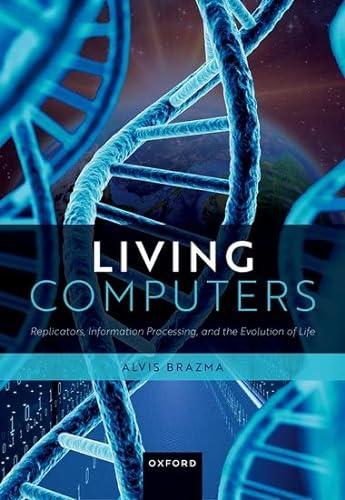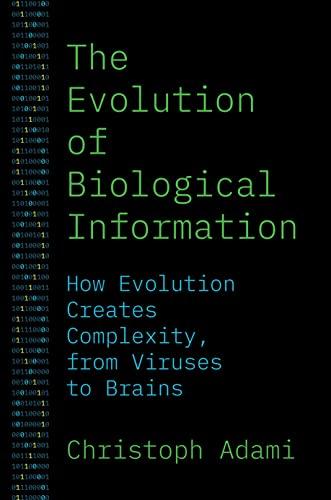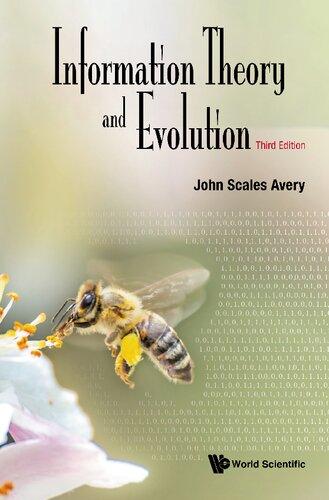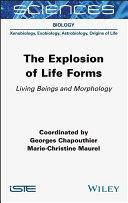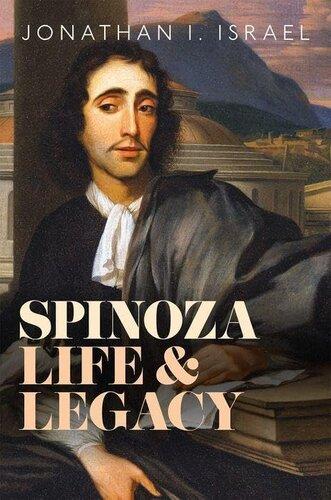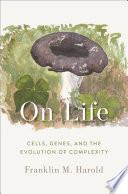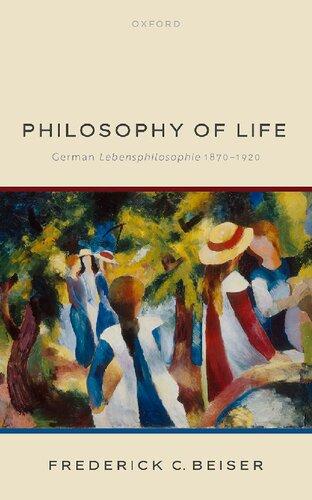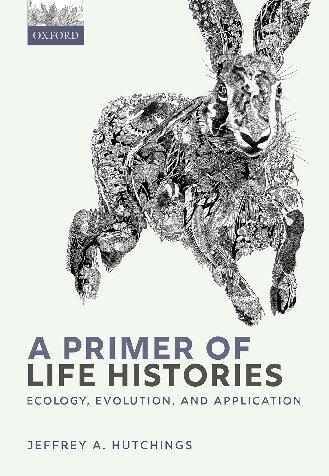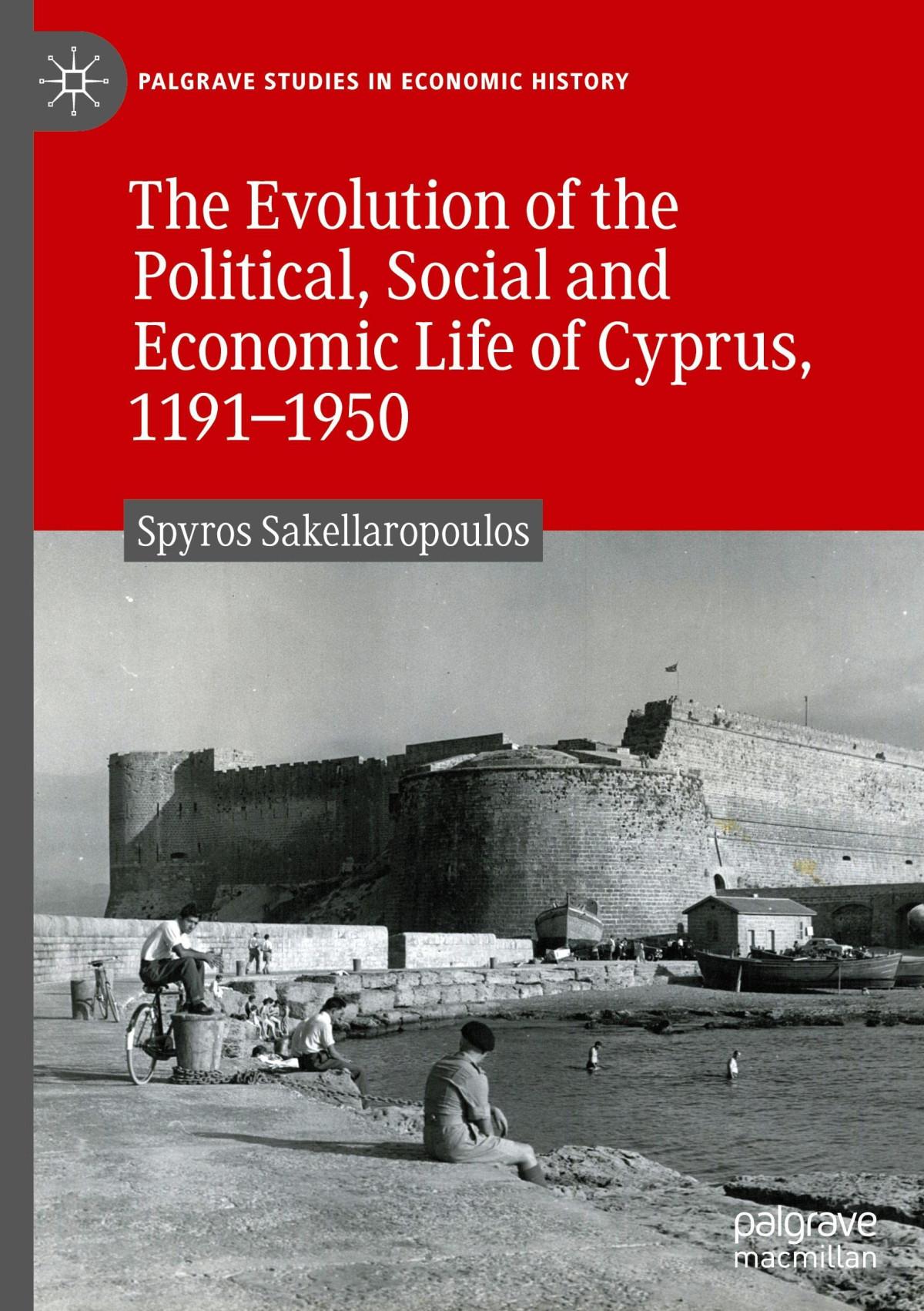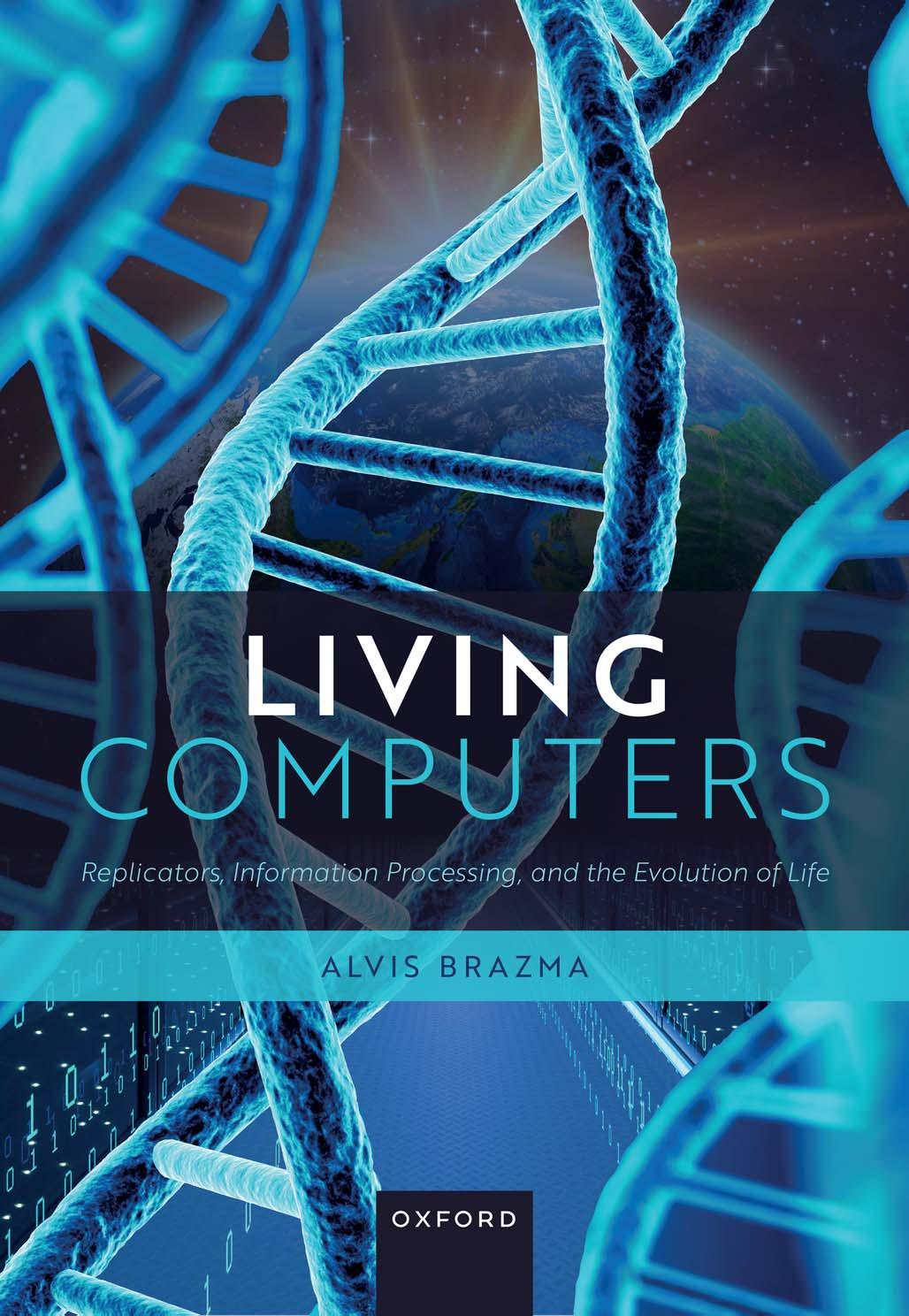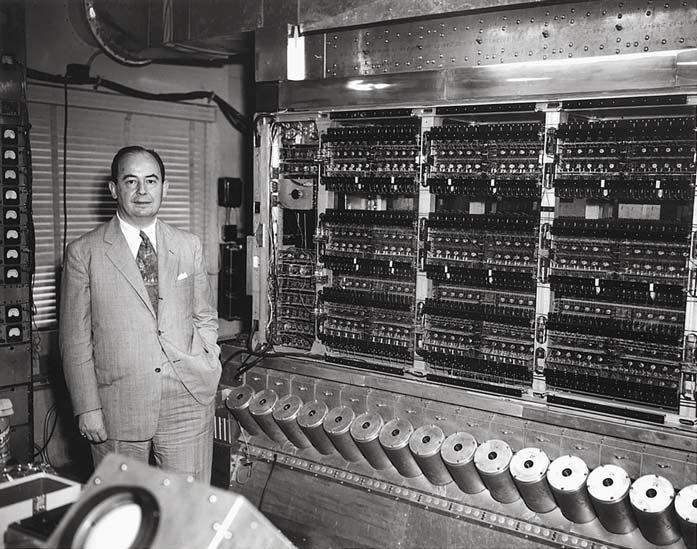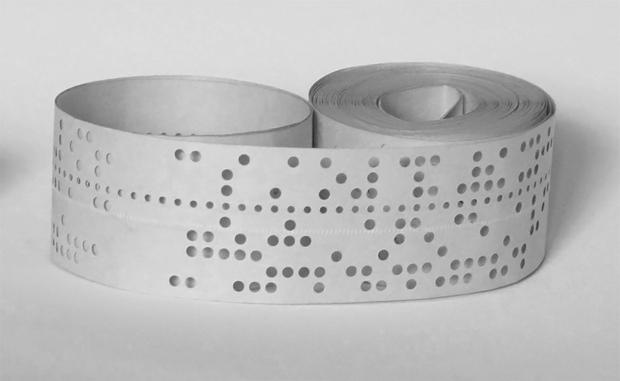LivingComputers
Replicators,InformationProcessing, andtheEvolutionofLife
AlvisBrazma
EuropeanMolecularBiologyLaboratory
EuropeanBioinformaticsInstitute
Cambridge,UK
GreatClarendonStreet,Oxford,OX26DP, UnitedKingdom
OxfordUniversityPressisadepartmentoftheUniversityofOxford. ItfurtherstheUniversity’sobjectiveofexcellenceinresearch,scholarship, andeducationbypublishingworldwide.Oxfordisaregisteredtrademarkof OxfordUniversityPressintheUKandincertainothercountries
©AlvisBrazma2023
Themoralrightsoftheauthorhavebeenasserted Allrightsreserved.Nopartofthispublicationmaybereproduced,storedin aretrievalsystem,ortransmitted,inanyformorbyanymeans,withoutthe priorpermissioninwritingofOxfordUniversityPress,orasexpresslypermitted bylaw,bylicenceorundertermsagreedwiththeappropriatereprographics rightsorganization.Enquiriesconcerningreproductionoutsidethescopeofthe aboveshouldbesenttotheRightsDepartment,OxfordUniversityPress,atthe addressabove
Youmustnotcirculatethisworkinanyotherform andyoumustimposethissameconditiononanyacquirer
PublishedintheUnitedStatesofAmericabyOxfordUniversityPress 198MadisonAvenue,NewYork,NY10016,UnitedStatesofAmerica BritishLibraryCataloguinginPublicationData
Dataavailable
LibraryofCongressControlNumber:2023933858
ISBN9780192871947
DOI:10.1093/oso/9780192871947.001.0001
Printedandboundby CPIGroup(UK)Ltd,Croydon,CR04YY
LinkstothirdpartywebsitesareprovidedbyOxfordingoodfaithand forinformationonly.Oxforddisclaimsanyresponsibilityforthematerials containedinanythirdpartywebsitereferencedinthiswork.
Formywife,Diana
Preface
Allcurrentlyknownformsofliferelyonthreetypesofmolecules:proteins—life’smain structuralandfunctionalbuildingblocks;DNA—life’sinformationcarrier;andRNA— themessengerprovidingthelinkbetweenthesetwo.Butwhatwaslifelikewhenitfirst emergedonEarthbillionsofyearsago?Whatwilllifebelikeinmillionsorbillions ofyearsifitstillexists?Canalivingbeingbemadeof,say,steel,copper,andsilicon? Andwhatisitthatdistinguisheslivingsystemsfromthosewedonotregardasliving?
Anessentialfeatureoflifeisitsabilitytorecord,communicate,andprocessinformation.Everylivingcelldoesthis.Everyanimalbraindoesthis.Andevenmore fundamentally,evolutionprocessestheinformationrecordedintheentirecollectionof DNAonEarthusingthealgorithmofDarwinianselectionofthefittest.Lifeandthe recordingofinformationemergedtogether;thereisnolifewithoutinformationand, arguably,thereisnoinformationwithoutlife.
Wedonotknowwhatthefirstcarriersofinformationwerewhenlifehadjustemerged, butforthelastfewbillionsofyears,themostimportantinformationstoragemedium onEarthhasbeenDNA.Oncelifehademergedandstartedevolving,theinformationinDNAwasaccumulating,atleastforawhile.Afewhundredthousandyears ago,quiterecentlyontheevolutionarytimescale,humanlanguageemergedandamajor transitionbegan;forthefirsttime,largeamountsofinformationbeganaccumulating outsideDNA.Mostlikely,informationintheworld’slibrariesandcomputercloudsis nowexpandingfasterthaninthegenomesofallspeciesonEarthtakentogether.Even moreimportantly,languagetriggeredevolutionarymechanismsdifferentfromandfaster thanbiologicalevolution,namelyculturalevolution.Theemergenceofhumanlanguage wasatransitionasremarkableastheemergenceoflifeitself.
Nevertheless,atleastatourcurrentstateofevolution,theinformationinDNAis indispensable;iftheDNAexistingonEarthweretobecometoocorrupted,allculturalinformationandlifeitselfwouldswiftlydisappear.Butmustlifebelikethis?Or canfuturecivilizations,possiblyinthousandsormillionsofyearscolonizingplanetsof distantgalaxies,bebasedonentirelydifferentprinciples?Cantherebeanothermajor transitioninwhichDNAbecomeslesscentral?
Thisbook,inwhichlifeandevolutionareexploredasinformationprocessingphenomena,isaimedateverybodyinterestedinscienceandcomfortablewithelementary mathematics.Itwillalsobeofinteresttostudentsandscholarsfromawiderange ofdisciplines,fromphysics,computing,andbiologytosocialsciencesandphilosophy.Thisbookisforeveryonewhohaseverwondered:howdolivingsystemswork? Whendoassembliesofnon-livingmoleculesbecomelivingorganisms?Wheredoes life’scomplexitycomefrom?AndwherewilllifegoaftertheSolarsystemceasesto exist?Thefascinatingideaofviewinglivingorganismsascomputersandtheevolution oflifeasinformationprocessingwillbeenrichingforeveryoneinterestedinourdaily andlong-termexistence.
Introduction
TheHistoryofeverymajorGalacticCivilizationtendstopassthroughthreedistinct andrecognizablephases,thoseofSurvival,InquiryandSophistication,otherwise knownastheHow,Why,andWherephases.Forinstance,thefirstphaseischaracterizedbythequestion‘Howcanweeat?’,thesecondbythequestion‘Whydowe eat?’andthethirdbythequestion,‘Whereshallwehavelunch?’
(DouglasAdams,
TheHitchhiker’sGuidetoTheGalaxy)
Howcomplexdoesthesimplestlivingbeinghavetobe?Howmanydifferentpartsit needs?Canthecomplexityoflifebemeasured?Asproteinsarethemostdiversecomponentsofallknownlifeforms,onepossiblewaytomeasurethecomplexityofanorganism isbycountinghowmanydifferentproteinmoleculesithas.Bacteria,arguablythesimplestknownfree-livingorganisms,havehundredstothousandsofthem.Humanshave tensofthousandsofdifferentproteins,butsodootheranimals.Arehumansunique amonganimals?Ifyes,whatmakesthemspecial?Ontheonehand,inthenumberof differentmolecules,humansareofaboutthesamecomplexityasmanyotheranimals. Ontheotherhand,unlikeotheranimals,humanscanread,write,andplaychess.But socancomputers.Arehumansclosertootheranimalsortocomputers?
Thesearenotnewquestions.Morethan2000yearsago,theGreekphilosopherAristotlethoughtthatthedifferencebetweenthelivingandnon-livingwasinthepresenceor absenceofa‘soul’.ForAristotle,thereweredifferentlevelsofasoul:thenutritivesoul wascommontoalllivingthings,whereashigherlevelsofsoulaccountedforthelocomotiveandperceptivecapacitiesofanimals,includinghumans.Atthehighestlevelthere wastherationalsoul,uniquetohumans.Two-thousandyearslaterintheseventeenth century,withtheinventionofthemicroscope,AntonivanLeeuwenhoekdiscovered anothertypeoflife:microbes.Forawhile,itwasthoughtthatmicrobescouldspontaneouslyemergefromnon-livingmatter,blurringthedistinctionbetweenlivingand non-living.Thischangedwhen,inthenineteenthcentury,theFrenchscientistLouis Pasteurdemonstratedthatmicrobescouldnotappear denovo butcouldonlygrowfrom theonesalreadyinexistence.Thedistinctionbetweenlivingandnon-livingappearedto beclear-cutagain.Butwhatexactlyisthedividingline?
Thedevelopmentsofphysicsandchemistryinthenineteenthandtwentiethcenturies providedscientistswithnewwaysofinvestigatingthisquestion,buttheyalsoimposed newdemandsontheacceptableanswers.Theanswerswouldhavetobebasedonatomic
theoryandbeconsistentwiththelawsofphysics.Towardsthisgoal,in1944,oneof thefoundersofquantummechanics,ErwinSchrödinger,wroteabookcalled Whatis Life?,inspiringagenerationofscientistsandfacilitatingthedevelopmentofanewscientificdiscipline—molecularbiology.Schrödingerdescribedahypothetical‘codescript’ thatcarriesinformationpassedonbylivingorganismsfromgenerationtogeneration.
Aroundthesametimethatmolecularbiologywasemerging,thefirstelectroniccomputerswereinvented,andadifferentnewscientificdiscipline—computerscience—was alsodeveloping.Withit,thescientificconceptsof information and informationprocessing weresolidifying.Computersweredifferentfromothermachinesinthattheywereperformingintellectualratherthanphysicalwork.Thequestion‘canmachinesthink?’soon becameatopicfordiscussioninscienceaswellasinsciencefiction.Toanswerthisquestion,AlanTuring,oneofthefoundersofcomputerscience,proposedatest:ifahuman talkingto‘somebody’behindacurtainwasnotabletotellwhetherthat‘somebody’was humanornot,thenbydefinition,that‘somebody’couldthink.1 Butdoesbeingableto thinkhavetomeanbeingalive?Theconversedoesnotseemtobetrue:noteverything livingcanthink.
Inthe1950sthemolecularstructuresofincreasinglycomplexbiologicalmolecules weredeciphered.Thediscoveryofthedouble-helicalstructureofDNAin1953was adefiningmomentpavingthewaytounderstandingthemolecularbasisofbiological information:howitiscoded;howalivingcell,thebasicunitofallknownlife,usesit tofunction;andhowthisinformationispassedonfromgenerationtogeneration.A conceptuallinkbetweenbiologyandinformation/computersciencebegantoemerge.
Theinitialinputfromcomputersciencetobiologywasarguablyratherlimited,neverthelesscomputerscienceenteredtherealmofbiologyafewdecadeslater,inthe1980s. ThiswaswhenDNAsequencing—readingthesequencesofthemolecular‘letters’of DNA(readingSchrödinger’s‘codescript’)andtranscribingthemontopaperor,more usefully,intoacomputermemory—wasinvented.Thisabilitytoreadlife’sinformation moleculeresultedintheemergenceofanewscientificdiscipline—bioinformatics.Soon scientistsfoundthatanalysingDNAasasequenceofletters,ratherthanachemical,can revealmanysecretsoflife.Apparently,forlife’sprocesses,theinformationinDNAis atleastasimportantasthespecificchemistry.Buttowhatextentdoestheparticular chemistrymatteratall?
Allcurrentlyknownlifereliesonthesamecarbon-basedchemistry,whichseemsto suggestthatchemistrymatters.Butisthistheonlywayhowlifecanexist,orwasita historicaccidentthatlifeemergedonEarthbasedonthisparticularchemistry?Andeven ifthisspecificchemistrywastheonlypossiblewayhowlifecouldhaveemerged,does lifehavetoremainbasedonthesamechemistryinthefuture?Canlifeevolvetoinhabit verydifferentphysicalsubstancesanduseverydifferent,non-carbon-basedchemistry?
Perhapsevennochemistryatall?
InthisbookIwillarguethatfirstandforemost,livingmeansprocessinginformation.Iwillarguethattheemergenceoflifeandthefirstrecordingofinformationare intrinsicallylinkedandperhapsareoneandthesamephenomenon.Iwillshowthatbiologicalevolutioncanbeviewedascomputingwheretheinformationresidingintheentire
collectionofDNAonEarthisprocessedbythe geneticalgorithm ofDarwiniansurvival ofthefittest.Atleastinitially,aslifeonEarthwasevolvingandadaptingtochanging environment,informationstoredinDNAwasgrowing.Inasense,lifewaslearningfrom theenvironment,recordingwhatithadlearntinitsDNA.
Forbillionsofyears,alldurableinformationpresentonEarthwasalmostexclusively recordedinDNAorotherpolymermolecules.Butafewhundredthousandyearsago, thischanged.Humanlanguageemerged,providinganalternativemeansforrecording andtransmittinglargeamountsofinformationfromindividualtoindividualandfrom generationtogeneration.Informationbegunincreasinglyaccumulatinginsubstances differentthanDNA.Now,thereisprobablymoreinformationstoredintheworld’s librariesandcomputercloudsthaninthegenomicDNAofallthespeciesonEarth.Even moreimportantly,languageenabledinformationprocessingmechanismsdifferentfrom andmuchfasterthantheonesexistingbefore.Culturalevolution,enabledbylanguage, doesnothavetorelyonthesurvivalofthefittest;theinformationacquiredoverone’s lifetimecanbepassedontoothersandtofuturegenerations.
Nevertheless,atthepresentstageofevolution,theinformationinDNAandits Darwinianprocessingareindispensable:culturalinformationcannotbemaintainedor evolvewithouttheinformationinDNAunderpinningit.Butcanthischangeinthe future?Couldfuturecivilizations,whichinthousandsormillionsofyearspossiblybe colonizingplanetsofdistantgalaxies,bebasedonentirelydifferentprinciples,andmade ofentirelydifferentmolecules?CanlifeexistwithoutDNAorsimilarmolecules?Can civilizationexistwithoutlife?Ifthemaindefiningfeatureoflifeisinformationprocessing,thenperhapstheparticularsubstanceinwhichthisinformationisstored—DNA, RNA,paper,siliconchips,oranythingelse—becomessecondary.Orwilllifealways needDNAandtheDarwinianalgorithmworkinginthebackground?Whatwillthelife eventuallyescapingthedyingsolarsystembelike?
Theappreciationoftheroleofinformationandinformationprocessinginbiology canbetracedbacktothementionedErwinSchrödinger’sbook WhatisLife? andto publicationsofoneoftheco-discoverersofthestructureofDNA,FrancisCrick.The observationofthecentralroleofinformationinbiologyisatthebasisoftheso-called gene’s-eyeview introducedbytheAmericanandBritishbiologistsGeorgeC.Williams andRichardDawkins,statingthat genes—piecesofheritableinformation—arethemain objectofDarwinianselectionofthefittest.2 Butaspecialplaceinthedevelopmentof theideaofinformationasacentralconceptinbiologybelongstotheBritishbiologist JohnMaynardSmith.Inhisseminalbook TheMajorTransitionsinEvolution, 3 written withtheHungarianbiologistEörsSzathmáryandpublishedin1995,theauthorsshow thatthekeyeventsinbiologicalevolutioncanbeseenastransitionsinhowlifeprocesses information.
Withgenomesequencingnowacommodityandbioinformaticsbecomingamainstreamscience,thecentralroleoftheconceptofinformationinbiologyisbecoming increasinglyaccepted.Inhisrecentbook, TheDemonintheMachine, 4 thephysicistPaul Daviesexploresthelinksbetweentheconceptsofentropy,information,andlife,arguing thatinformationprocessingisattheverycentreoflife.Evenmorerecently,theNobel
LaureatePaulNursewritesabout lifeaschemistry and lifeasinformation inhispopular sciencebookthathasthesametitleasSchrödinger’s WhatisLife?.5
Inthisbook, LivingComputers,Idiscusshowlivingsystemswork,howlifeandinformationemergedalreadyintrinsicallylinked,howlifeandinformationprocessingevolved throughRNAandDNAtoneuralnetworksandtheanimalbrain,andcontinuedthrough humanlanguagetokick-startanewkindofevolution.Throughoutthebook,Itrytobe clearwhereIamdescribingtheconsensuswithwhichmostscientistswouldagree,note whereIamtouchingcontroversies,andstatewhereIamjustspeculating(andtomake surethatmyclaimscanbeverified,Iprovidemanyreferencestopeer-reviewedliterature).Mostofthebookconcernsthefirst,consensuspositions,eventhoughIoftentryto showtheestablishedknowledgeinnewlight,andIsometimesquestionanoddorthodox assumption.Noteverythinginthebookisapartoftheestablishedscientificconsensus. Thethesisthatlifeandtherecordingofinformationemergedjointlyseemsobviousto me,neverthelessthereisnoreferencetoscientificliteraturethatIcanfindwherethis hadbeenstatedexplicitly.Iarguethatlargeamountsofinformationcanberecorded andprocessedonlybydigital-combinatorialmeans,whichmayalsosoundcontroversial tosome.Thisthenfurtherleadstotheconclusionthatbeforehumanlanguageemerged, theonlymeanstorecordlargeamountsofinformationwereinpolymermoleculessuch asDNA.Probably,themostspeculativeismythesisthatthenewmeansofinformation recordingandprocessingresultingfromtheemergenceofhumanlanguagecantake evolutioninentirelynewdirections.Butaboutthefutureoflife,clearly,wecanonly speculate.
HowtoCloneOneself?
HerMajestypointedtoaclockandsaid,‘Seetoitthatitproducesoffspring’.
(Anonymousaccountofanallegeddiscussion betweenRenéDescartesandQueenChristinaofSweden,1649–1650)
Isitpossibletomakeamachinethatclonesitself?Amachinewhichwhensetinmotion, goesonandassemblesitsownreplica?Inotherwords,amachinethatreproduces?The abilitytoreproduceisoftenseenasoneoftheprincipaldividinglinesbetweenliving andnon-living.Allegedly,whenintheseventeenthcentury,theFrenchphilosopherand mathematicianRenéDescartesinaconversationwithQueenChristinaofSwedensuggestedthatananimalbodycouldberegardedasamachine,theQueenrepliedthatthen aclockshouldbeabletoproduceoffspring.Obviously,clocksdonotdothis,butis itpossibletobuildanautomatonorarobotthatcancloneitself?Inotherwords,an automatonthatcan self-reproduce
Regardlessofwhetherthisconversationreallytookplace,orhowaccuratethenarrativeis,itisquitelikelythatthephenomenonof self-reproduction or self-replication has beenoccupyingthemindsofthinkersandphilosophersforcenturies.However,thefirst trulyscientificinvestigationofthisquestionapparentlybeganonlywiththeonsetofthe computerage.InJune1948,theHungarian-bornAmericanmathematicianJohnvon Neumann(Figure 1.1)gavethreelecturestoasmallgroupoffriendsattheInstitute forAdvancedStudyatPrincetondiscussinghowtobuildamechanicalself-reproducing machine.1
Bythattime,vonNeumannwasalreadyanestablishedscientist,havingmademajor contributionstoquantummechanics,statisticalphysics,gametheory,andthefoundationsofmathematics,amongstotherdisciplines.Inearly1940s,vonNeumannjoined theprojectattheUniversityofPennsylvania’sMooreSchoolofElectricalEngineering, todesigntheElectronicDiscreteVariableArithmeticComputer—EDVAC.2 VonNeumann’s FirstDraftofaReportontheEDVAC,publishedin1945,isnowwidelyregarded asthefirstdescriptionofastored-programcomputer—acomputerwhichisgivenits operatinginstructionsbysoftware,asallcomputersnoware.3
Inthisreport,vonNeumannabstractedfromthespecificelectronicparts,suchas electronvacuumtubesorelectricrelays,usedincomputersatthetime,andinstead talkedaboutidealized logicalswitches.Heusedananalogybetweenacomputerand brain,comparinghislogicalswitchestoneurons.Hethoughtthatthespecificphysical
Figure1.1 JohnvonNeumannstandinginfrontofcomputer. Photographer,AlanRichards.FromtheShelbyWhiteandLeonLevyArchivesCenter,Institutefor AdvancedStudy,Princeton(NJ).
implementationoftheswitchescouldsoonchange,andhewasright:itwasnotlong beforethetransistorwasinventedandreplacedthevacuumtube.4 ForvonNeumann, thelogicalbasisofcomputingwasmorefundamentalthanthespecificphysical implementations.In1957,lessthantenyearsaftergivingthementionedlectureson self-reproduction,attheageof53,vonNeumanndiedfromcancer.
Aroundthesametimewhenthefirstelectroniccomputerswerebeingbuilt,inthe 1940sand1950s,geneticistsandbiochemistswereclosinginonunderstandingtheprinciplesofthemolecularbasisoflife.AlthoughvonNeumanndidnotplayamajorpartin thiseffort,hewasdiscussinghisideaswiththeleadingbiochemistsandgeneticists,and whenworkingontheproblemsofcomputing,healwayskeptreturningtothecomputer–brainanalogy.ItisquitelikelythatvonNeumann’sinterestinself-reproductionwas motivatedbywhathesawastheanalogybetweenmachinesandlivingorganisms,and byhisdesiretounderstandthe‘logical’basisoflife.
ForvonNeumann,itwasclearthataself-reproducingdevicewaspossible;after all,livingorganismsreproduce.Forhimthequestionwashowtomakesuchadevice
andhowcomplexthesimplestpossibleself-reproducingsystemwouldhavetobe. VonNeumannnoticedaparadox.ForadeviceAtobeabletobuildanotherdevice B,deviceAwouldhavetocontain,insomesense,adescriptionofB.Ifso,itappeared thatAwouldhavetobemorecomplexthanB.Thus,adevicecouldonlybuilddevices simplerthanitself.VonNeumanncalledthisphenomenonthe‘degenerativetrend’.But thiscontradictedtheobservationsthatlivingorganismsnotonlymanagetoproduce descendantsascomplexasthemselvesbut,throughevolution,alsoincreasinglycomplexones.Howcouldadevicebuildsomethingascomplexorevenmorecomplexas itself?
Lookingforasolution,vonNeumanncameupwiththeconceptofthe UniversalConstructor—anabstractionofageneral-purposerobotwhich,givenappropriate instructionsandthenecessarymaterials,couldbuildwhateverithasbeeninstructed tobuild.TheUniversalConstructorcouldbegiveninstructionstobuilditself,though tocompletethereproductioncyclethenewdevicewouldalsohavetobeequipped withanewcopyoftherespectiveinstructions.VonNeumannarguedthattheUniversalConstructorwouldinevitablyhavetobequiteacomplexdevice,andconsequently, aself-reproducingmachine—arobotthatclonesitself—couldnotbesimple.Healso speculatedhowrandomerrorsinsuchself-reproducingdevicescouldpotentiallylead toevolutiontowardsincreasingcomplexity.Thus,vonNeumannpostulatedthatthere isacomplexitydividinglinebelowwhichonlythedegenerativetrendcouldoccurbut abovewhichevolutiontowardsincreasingcomplexitywaspossible.5
Amechanicalreplicator
InthementionedlecturesatPrinceton,andayearlaterintheHixonSymposiumon CerebralMechanismsinBehavior, 6 vonNeumanndiscussedthegeneralprinciplesatthe basisofsuchamechanicalself-reproducingdevice.Hecalledthisa kinematic replicator. Kinematics isabranchofphysicsthatstudiesmotionofbodiesandtheirsystems.Von Neumannwasinterestedinself-reproductioninits‘logicalform’andwantedtoabstract fromproblemssuchassupplyofenergy,thenatureofmolecularforces,orchemistry. Therefore,thebuildingblocksofthereplicatorwereallowedtobemorecomplexthan individual‘molecules,atomsorelementaryparticles’.InalectureattheUniversityofIllinois in1949hesaid:
Drawupalistofunambiguouslydefinedelementaryparts.Imaginethatthereisapracticallyunlimitedsupplyofthesepartsfloatingaroundinalargecontainer.Onecanimaginean automatonfunctioninginthefollowingmanner:Italsoisfloatingaroundinthismedium;its essentialactivityistopickuppartsandputthemtogether....7
Thisprocessshouldresultinanewcopyoftheautomatonbeingbuilt.VonNeumann suggestedalistofeightdifferent elementaryparts,whichhecalledthe stimulusproducer, rigidmember, coincidenceorgan, stimuliorgan, inhibitoryorgan, fusingorgan, cuttingorgan,
and muscle.8 The stimulusproducer servedasasourceofdiscretepulsesofsignalsto maketheotherpartsact.The rigidmember wasthephysicalbuildingblockfromwhich theframeoftheautomatonwasconstructed.Thenextthree‘organs’—the coincidence, stimuli,and inhibitoryorgans werewhatwewouldnowcallthe logicalgates AND,OR, andNOT—thebasicbuildingblocksofacomputer.9 VonNeumannusedtheseelements todesignthecontrolmodule—thebrainofthereplicator,whichprocessedthesignals generatedbythestimulusorgantoguidetheconstruction.Thelastthreeorganswere theretofollowtheinstructionsofthiscontrolmoduleandtoperformtheactualphysical construction.The fusingorgan,whenstimulatedbyasignal,solderedtwopartstogether; a cuttingorgan,whenstimulated,unsolderedaconnection;andfinally,the muscle was usedtomovetheparts.Theautomatonbuiltfromtheseelementswouldbe‘floating inacontainer’alongsidesparepartsandfollowingtheinstructionsrecordedonatape, tellingitwhichpartstopickupandhowtoassemblethem.
Onacloserlook,therearethreemainideasatthebasisofvonNeumann’sselfreproducingautomaton.Thefirstcomesfromasimpleobservationthatifonehasto copyacomplexthree-dimensionalobject,forinstancetomakeareplicaofahistoric steam-engine,itisusuallyeasierfirsttomakeablueprintofthisobjectandthenbuild bytheblueprint,ratherthantotrytocopythethree-dimensionalobjectdirectly.This, indeed,ishowthingsareusuallymanufactured.Itmayalsohelptosupplementthe blueprintwithasequenceofinstructionsdescribingthestepsoftheconstructionprocess.Forinstance,flat-packfurnitureusuallycomeswithablueprintandaninstruction manualdescribingtheorderinwhichthepiecesshouldbeputtogether.Iftheseinstructionsaretobeexecutedbyarobot,theneverystepwillneedtobeencodedinaprecisely definedway.Nowadays,suchinstructionswouldnormallybestoredonsomeelectronic informationcarrier,suchasa flash memory-card,orstreamedwirelessly,butintheearly daysofcomputing,apunchedtape,suchastheoneshowninFigure 1.2,wouldbeused. Conceptually,suchatapecanberegardedasaone-dimensionalsequenceofsymbols encodingtheinstructions.
Thesecondidearepresentsanothersimpleobservationthatitiseasiertocopyaoneortwo-dimensionalobject,suchasapunch-tapeorthisprintedpage,thanathreedimensionalobject.Forinstance,tocopythepunch-tapeinFigure 1.2,onecouldputit ontopofanunused(unperforated)tapeandpunchholeswheretheyalreadyareinthe original.Itshouldnotbetoodifficulttobuildapurelymechanicaldeviceautomating thisprocess.
VonNeumanndescribedadevicethatwouldmechanicallycopyachainencoding instructionsasasequenceoftwodifferenttypesoflinks,suchasshowninFigure 1.3A. Conceptually,suchachaincanbeviewedasasequenceof0sand1s,andaswewill seelater,anypieceofinformationcanbeencodedassuchabinarystring.Infact,it maybeeveneasiertocopyachainifitisdesignedastwo‘complementary’chains, asshowninFigure 1.3B,eachunambiguouslydefiningthecomplement.Wesimply needtodecouplethecomplementarychainsanduseeachasatemplatetomakeanew complement,asshowninFigure 1.3C.Oncetheprocessisfinished,wehavetwocopies oftheoriginalchain.Areaderwithsomeknowledgeofmolecularbiologymaynoticea similaritybetweenthismethodandhowaDNAmoleculeiscopiedinalivingcell.
Figure1.2 Punched(perforated)tapeswerewidelyusedinthe1950sandthe1960sinelectronic computersfordatainput.Althoughsuchatapeisessentiallyatwo-dimensionalobject,abstractlywe canviewitasaone-dimensionalsequenceofsymbols.
(AdaptedfromWikimedia,authorTedColes.)
Thethirdidea,themostfundamentalandnon-trivialofthethree,wasthatofthe alreadymentionedUniversalConstructor.VonNeumannassumedthatthismachine wouldreadasequenceofinstructionsgiventoitencodedonatapeorasachainof elementsasshowninFigure 1.3,andbyfollowingtheseinstructions,itwouldbuild anyspecifiedthree-dimensionalobject.Thisobjectcouldbeanothermachine.Arobot abletoreadinstructionsgiventoitonaperforatedtapehadalreadybeeninventedin theeighteenthcenturybytheFrenchweaver,BasileBouchonofLyon.Bouchonbuilta loomthatfollowedinstructionsencodedonsuchatape,translatingthemintoweaving patterns.Ofcourse,thatwasnotageneral-purposerobotbutaloom.Onecansaythat vonNeumann’sUniversalConstructorwasanextensionofBouchon’sloomtowards Turing’sUniversalMachine,discussedlaterinthischapter.
Letusseehowacombinationofthesethreeideascanbeusedtomakeaselfreproducingdevice.IwillroughlyfollowvonNeumann’sdescription,whichissomewhat abstract,butitwilllaterhelpustoseetheanalogybetweenhisself-reproducing automatonandthemainprincipleshowalivingcellreplicates.
SupposeXisanarbitraryobjectmadeofvonNeumann’seightelementaryparts.This object,justlikeanyobject,canbemanufacturedbytheUniversalConstructor,therefore thereexistsasequenceofinstructionsfollowingwhichtheUniversalConstructorproducesX.Letusdenotethissequenceofinstructionsbycode(X).Conceptuallycode(X) isasequenceof0sand1s,physicallythisisencodedonoaperforatedtapeoranyway whichthisUniversalConstructorcanread.Whatmattersisthatontheinputofcode(X), theUniversalConstructoroutputsobjectX.
Figure1.3 A) Achainoftwodifferenttypesoflinksencodingabinarystring. B) Two ‘complementary’chainsofsuchlinksformingadoublechain. C) Apossiblemechanismofinformation copyingthatexploitscomplementarity:thecomplementarychainsareseparated,andanewcompliment isassembledontoeachofthemfrom‘free’links‘floating’inthemedia.Oncebothchainsarefully separatedandthecomplementsassembled,theneighbouringelementsofthenewlyassembled complementsonlyneedtobe‘stapled’togetherandanewcopyoftheentirechainisobtained.Itisnot clearifsuchcomplementaritybasedapproachhadoccurredtovonNeumann;hedoesnotmentionthis possibility.Aswewilldiscussin ChapterIII,inDNAreplicationasimilarmechanismisused.
Forbrevity,letusdenotetheUniversalConstructorbyU.Tocompletetheconstructionofaself-reproducingmachine,inadditiontoUweneedtwoother,simplerrobotic devices,whichwedenotebyRandC.ThedeviceR,called codereplicator,giventhe tapecode(X),makesanewcopyofcode(X).Thatis,Rmakesanothercopyofthe tapecontainingthesameinstructions.Asalreadynoted,copyingatapeisquiteasimple procedure.
ThethirdrobotCcontrolsbothUandRinthefollowingway.Givencode(X),Cfirst runsreplicatorR,thusmakinganewcopyofcode(X).ThenCrunsUoncode(X),thus producingobjectX.Finally,Cattachesthenewcopyofcode(X)tothenewlycreated XandreleasesthenewobjectX+code(X).InvonNeumann’sownwords,it‘cutsthe newobjectloose’.Here,followingvonNeumann,weusesymbol‘+’todenotethatthe twoobjectsaresomehow‘tied’together.
NowstartwiththecombinedrobotU+R+C+code(X).First,CinstructsUtorun oncode(X).Theresultis:
U+R+C+code(X),X
Next,CinstructsRtomakeanothercode(X);theresultis:
U+R+C+code(X),X,code(X)
Finally,U‘ties’Xandcode(X)together;theresultis:
U+R+C+code(X),X+code(X)
ButnowrecallthatXwasanarbitraryobject.Inparticular,Xcanbesomesortofa device,forinstance,wecantakeU+R+CforX(thatis,X=U+R+C).Ifwedothis, andgivecode(U+R+C)toourthree-partrobotasaninput,westartwith:
andweendwith:
TherobotU+R+C+code(U+R+C)hasmanagedtobuilditsowncopy;ithasreproduceditself.The‘degenerativetrend’hasbeenbroken—wehavearobotthatbuilt anotherrobotascomplexasitself.Onemaywonderhowexactlyitdidthis,butitdid.We neededtwoseparatedevices:theUniversalConstructorUandcodereplicatorR.Could theUniversalConstructordoboth?ForvonNeumann’sideatowork,theprocessRof replicatingthetapehadtobecarriedoutseparatelyfromprocessU(ascepticreader cantrytomergebothprocessesintooneandseethedifficulties).Aswewillseelater, thisisalsowhathappenswhenalivingcelldivides;thetapethereisthegenomicDNA, whichisapolymer‘chain’offourdifferentelements.DNAreplicationisaprocessthat isimplementedinalivingcellbyadistinctmachinery.
NotethattheobjectU+R+C+code(U+R+C)isanobjectthatcontainsitsown description:code(U+R+C)describesthedeviceU+R+C.Thisiswhathasallowed ittobeatthe‘degenerativetrend’.Butthisalsoturnsouttobeatthebasisoflife.As SydneyBrenner,whosharedtheNobelPrizeinphysiologyandmedicinewithRobert HorvitzandJohnSulstonin2002‘fortheirdiscoveriesconcerninggeneticregulationof organdevelopmentandprogrammedcelldeath’,wrotein2012:
ArguablythebestexamplesofTuring’sandvonNeumann’smachinesaretobefoundinbiology. Nowhereelsearetheresuchcomplicatedsystems,inwhicheveryorganismcontainsaninternal descriptionofitself.10
WhatvonNeumanndescribedinhislectureswasonlyanidea;hedidnotbuildaphysical mechanicalself-reproducingmachine.Thecomplexityofsuchamachinewouldhave
U+R+C+code(U+R+C)
U+R+C+code(U+R+C),U+R+C+code(U+R+C)
beenanenormousengineeringchallengein1950sandstillistoday.Somepartsofvon Neumann’sdevice,asheproposedit,havebeenbuilt,andsuggestionshavebeenmade thatcompletingthecyclemustbepossible.However,astheEnglishsay:‘theproofof thepuddingisintheeating’.Thekinematicalreplicatorisstillnotthereand,aswewill discusslater,possiblyforagoodreason—thenumberofmechanicalstepssuchadevice wouldhavetocarryouttocompletethereproductioncyclemaybeprohibitive.Toprove thatself-reproductionislogicallypossible,asamathematician,vonNeumannturnedto developingarigorousmathematicalmodel.
Self-reproductionwithouthand-waving
Inexperimentalsciences,theultimateproofthatanapparatusdoeswhatitisclaimedto doisanexperiment.Willthemachinebuilditsreplicaornot?Buteveninexperimentalsciences,non-trivialreasoningmaybeneededtoconcludethattheexperimenthas indeedprovenwhatisclaimed.Isthereplicaauthentic?Wasitthemachinethatcloned itselforwasitthecomplexenvironmentarounditthatmadethecopy?Inmathematics, theproofisachievedbydefiningtheproblemandtherulesforsolvingitrigorously,and thenfindingasolutionwithintherules.Thereasoningthatweusedtoarguehowvon Neumann’skinematicreplicatorbuiltitsowncopydidnotquitefitthisbillofrigour.For instance,the + signwasnotdefinedrigorously.Obviously,thiswasnotanarithmetic addition,itwasakindofattachmentbetweentheobjects,notdefinedprecisely.Canwe defineandsolvetheproblemofself-reproductionmathematically?Whatisthesimplest mathematicalmodelinwhichthephenomenonofself-reproductioncanbedescribed rigorously—withoutwhatmathematicianscall hand-waving?
Thosewhohavestudiedcomputerprogrammingmayhavecomeacrossanexercise: writeacodethatprintsitsowntext.Ortobeprecise,acodethatinstructsthecomputer toprintatextidenticaltothiscode.Suchaprogramissometimesreferredtoasa quine.11 Incomputerprogrammingitisdifficulttocheat—iftheprogramdoesnotdothejob,no amountofhand-wavingwillmakeitwork.Thosefamiliarwithcomputerprogramming cancheckthatcodinga quine isanon-trivialtask.However,itwasprovenbyoneofthe foundersofcomputerscience,theUSmathematicianStephenKleene,thatitispossible tocodeaquineinanygeneralenoughprogramminglanguage.Anin-depthdiscussion ofquinesandtheirrelevancetobiologycanbefoundintheclassicbook Gödel,Escher, Bach byDouglasHofstadter.12
Wecanmodifya quine sothatinsteadofprintingthetext,theprogramcopiesitsown codeoveracomputernetworktoanothercomputer.Thisiswhatcomputervirusesdo.A computervirusisaself-reproducingcode.DoessuchavirusachievewhatvonNeuman setouttodo?Onlyinaratherlimitedsense.Acomputervirusreplicatesbecausethe codeisexecutedbycomputerhardwareusinganoperatingsystem,whichusuallyis morecomplexthanthecodeofthevirusitself.Thosewhoarefamiliarwithbiology willnoticethatthesameistrueinrespecttobiologicalviruses—toreplicateviruses needthemachineryofalivingcell,whichtypicallyismorecomplexthanthevirus. VonNeumann’skinematicreplicatorwassupposedto‘float’inanenvironmentsimpler thanitself.
Tohaveafullanalogueto quine inthephysicalworldofatomsandmolecules,we wouldneedtohaveaprogramforacomputerequippedwithathree-dimensionalprinter (orarobot),whichinadditiontocopyingitselfwouldalsohavetoinstructthecomputer andprinterto‘print’anothercomputerandprinter,andfinallyloaditselfintothenew computer.ThiswouldbeaversionofvonNeumann’sself-reproducingdevice,where theprogramwouldbeanalogoustoitstape.
AsvonNeumannnotedinhislectures,computersoutputaclassofobjectsthatis ratherdifferentthanthemselves—theycanprintatextorsendacodeelectronicallyto anotherdevicebuttheydonotmakephysicalobjects.VonNeumannwantedtofinda mathematicalmodelofadevicethatwouldmakeanobjectofthesameclassasitself.
InspiredbyhisfriendandcolleaguePolish-AmericanmathematicianStanislawUlam, vonNeumannturnedto cellularautomata—twodimensionalstructuresorconfigurations (drawnonaplane)thatdevelopaccordingtowell-definedrules.Thegoalwastofind asetofrulesandaparticularinitialstructuresuchthataftersometime,twostructures identicaltotheoriginalwouldemergeontheplane.
Cellularautomataand Life
Probablythebest-knownexampleofcellularautomataisthe GameofLife,orsimply Life, inventedbytheBritishmathematicianJohnHortonConwayatCambridgeUniversity. Thisgamewasintroducedtothegeneralpublicinthe1970byMartinGardner,the legendaryeditorofthecolumn MathematicalGames inthepopularsciencemagazine ScientificAmerican.13 Atthattime,computerswerebecomingcheaperandaccessibleto manyscientists,andincreasinglytoeveryoneinterested,whichmostlikelycontributed tothepopularityofthegame.Nowtherearemanywebsitesoffering Life online;tosee whatfun Life canbe,thereadernotyetfamiliarwiththisgamemightfindandtryone ofthesewebsitesout.LesswellknownthanthegameitselfisthatConwayinvented Life thinkingaboutvonNeumann’sproblemofself-reproduction.In1986,afterleaving Cambridge,ConwaybecametheJohnvonNeumannChairofMathematicsatPrinceton University.
The GameofLife,unlikereallife,isgovernedbysimplerules,butlikereallife,itis veryrichinpossibilities.Althoughtoseetherichnessof Life oneneedsacomputer,itcan beplayedonasheetofsquaredpaperbyoneplayer.Conceptuallythesheetisofinfinite size,asitcanalwaysbeextendedasnecessarybyaddinganothersheet.Eachcellcanbe inoneoftwo states;occupied—alive,orempty—dead (quiescent state).Eachsquareisa cellwitheightneighbours—onetotheleft,onetotheright,ontop,beneath,andfour diagonally.Thecreativepartofthegameistofillintheinitialconfiguration—tochoose whichcellsare alive atthestart.Afterthat,theconfigurationdevelopsfollowingstrict deterministicrulesindiscretestepsortime-points.Forthedescriptionof Life’srulesand howsomeinitialconfigurationsdevelopseeFigure 1.4.
Amongstthesimplestconfigurationsinthefigure, glider takesaspecialplace:every fivesteps glider rebuildsitself,shiftedbyoneposition,thusmovingdiagonallyonthe grid. Gosperglidergun or cannon isamorecomplexconfiguration,whichperiodically
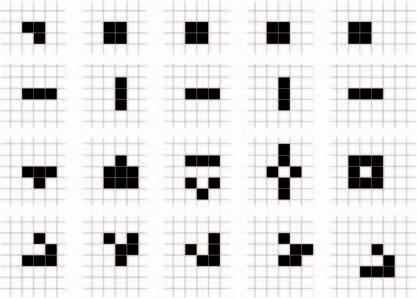
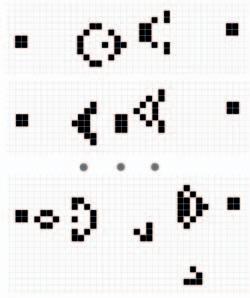
Figure1.4 Left. SimpleconfigurationsinConway’sGameofLifeandhowtheydevelop.Atevery consecutivetime-point,anewconfigurationisdrawnbythefollowingrules.Acellis alive (filled)inone oftwocasesonly:1)itwas alive intheprevioustime-point,andithadtwoorthree alive neighbours,or 2)itwas notalive (wasempty)intheprevioustime-pointandhadexactlythree alive neighbours. (Thus,exactlythree alive neighboursofanemptycellgivebirthtoanew alive cell,whileifan alive cell haslessthantwoormorethanthree alive neighbours,it dies of‘lonesomeness’or‘overcrowding’, respectively.)Followingtheserules,ablockoffourcellsstaysintact.Arowofthreeconsecutivecells (blinker)periodicallyturnsitselfintoacolumnofthreecellsandback.A glider movesdiagonally throughspace—itiseasytocheckthatafterfourstepsitwillhavereconstructeditselfbyonepositionto therightanddownwards.Thereadermaytryoutwhathappensto tetromino aftertime5. Right Gosperglidergun (or cannon)periodicallyshootsgliders.Thefirstgliderappearsattime-point16, andthenagain,everyconsecutive20time-points.Toappreciatetherichnessofsuchconfigurationsin full,oneneedstouseacomputer(forinstance,Wikipediaoffersaninteractivewebsite).
shoots gliders inaparticulardirection.Itmaybeexcitingtowatchonacomputerscreen whathappenswhentwocannonsareshootingglidersateachother;dependingontheir relativeposition,impressivefireworkscanhappen.
Most Life configurationswilleventuallybecomestatic(like block inFigure 1.4)orget intoaloopofsomeperiodicity(like blinker).Thesecanbeviewedas settled configurationsasnothingnewcanhappen.Someconfigurations,however,maygoondeveloping inanontrivialwayforever;foramathematicallymindedpersonitcanbeanexciting exercisetotrytofindsomeofthem.Ingeneral,itisnotpossibletotellifaconfigurationwillsettleornotinanyotherwaythanfollowingitsdevelopmentuntilitsettles,or maybeitdoesnot.Ifitsettles,wecanspotthis,butitisimpossibletoknowhowlong oneshouldkeepfollowingaconfigurationthatrefusestosettle.Thisisamathematical fact(atheorem).14
Buthereweareprimarilyinterestedincellularautomataasamodelfor selfreproduction—isthereaconfigurationsuchthatfollowingtherules,atsomepointtwo configurationsidenticaltotheoriginalwouldemerge?
Self-reproducingstructures
Tobuildamodelforaself-reproducingdevice,vonNeumannusedaversionofcellular automatadifferentfromConway’s Life.Cellsinhisautomatahad29differentstates15 ratherthantwo,asin Life.Hisconstruction,schematicallyshowninFigure 1.5,was designedtoemulateatwo-dimensionalrobot.16 Therobothada‘constructionarm’, whichperformedtheactualtaskofassemblinganewdevice,likearoboticarmwould beusedtobuildaphysicalstructure.VonNeumanndescribedhowtosimulatevarious elementsofthisrobot,includingwiresthroughwhichcontrolsignalsweresent.These signalswereprocessedinthecontrolunitsbuiltfromthelogicalgates(alsoimplemented
COMPLETED PORTION OF CONSTRUCTED AUTOMATON
CONSTRUCTING ARM
(X0 ,Y0 )
UNCOMPLETED PART OF CONSTRUCTED AUTOMATON
CONSTRUCTING AUTOMATON
(NOT DRAWN TO SCALE)
Figure1.5 ThetessellationstructureschematicallyrepresentingvonNeumann’sUniversalConstructor (From Burks,1970).
(0,0)
